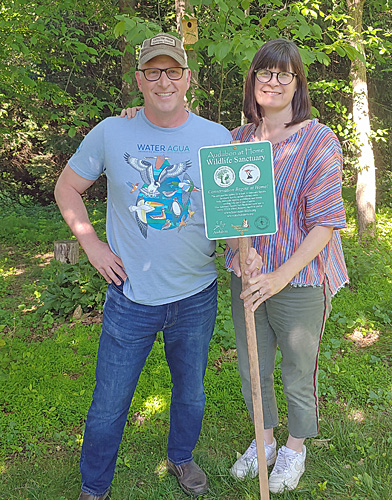Volume 28 Issue 3, Summer 2023
by Scott Harris
I have lived in Purcellville for over 25 years, on a small quarter-acre suburban property within the town limits. We are lucky, in that our quarter acre backs up to our community common land, which encompasses a section of Catoctin Creek and is further abutted by the town’s Suzanne R. Kane Nature Preserve. So my tiny lot feels a lot bigger than it is.
When we moved in, way back in 1997, the land was a former cornfield as part of a now-defunct farm. We kept some of the forestland that surrounds the creek in our backyard, but the rest of the lot was scraped of all its topsoil and planted with fescue, as is so often the case.

Homeowners Scott and Becky Harris show off the sign designating their Purcellville property an Audubon at Home Wildlife Sanctuary. Photo courtesy of Scott Harris.
Being an avid gardener, I began creating beds and planting bulbs and perennials, mostly in an effort to shrink the amount of grass to mow. Early on, we consulted with a landscape architect, and she put together a plan for planting trees and shrubs on our property. I didn’t realize or appreciate it at the time, but she chose native varieties of plants for us, like mountain laurel, dogwood, winterberry hollies, etc.
It wasn’t until recently, having become a member of Loudoun Wildlife Conservancy, that I really began to appreciate the role that native plants play in our local ecosystems. I heard about the Audubon at Home program and decided to sign up — if only to learn a little bit more about my property and its potential.
The Audubon at Home application starts with a survey: Do you provide habitat for pollinators? Is there a water source for animals? Do you use sprays/insecticides? And so on. As I was filling out the survey, I realized that I had come quite a long way in the last quarter century, and things were looking very good for my property actually qualifying as it is. The final section of the survey was demonstrating that at least ten target species (like bats, birds, salamanders, etc.) have been seen on the property. As an avid iNaturalist user, I was able to give exact time and date stamps of our animal visitors for the application.
Pretty soon after sending in the application, three Audubon at Home ambassadors, Jennifer Lumley, Sue Russell, and Susan Ferster, showed up for an on-site visit. That visit was really more of a learning session for me. We walked the property and talked about my intentions, both past and present. In general, I wanted to create a more inviting space for pollinators, have a low maintenance yard, and produce pretty blooms to look at, while still fitting within my HOA’s constraints to have a neat and tidy-looking, mowed front lawn. The three ambassadors could not have been more wonderful. They were friendly, knowledgeable and helpful, and had so many ideas for how to improve my property. In the end, we made several discoveries (both pawpaw and green ash saplings in my rear forest!) and they made several recommendations for improving the beds I have.
Armed with the final survey report, which was chock-full of recommended plant species, tips on how to control invasives, and other helpful resources, I headed off to Watermark Woods – Native Plants to fill my shopping cart. I came home with ten different species of plants, including false indigo, Wild Senna, Mayapple, goldenrod, and Spicebush. Spending one glorious day of gardening, I got all the plants (over 50!) into the ground. I’ve been watering and checking on them frequently, and am happy to report the first blooms are emerging!
One thing that surprised me about the Audubon at Home certification experience was how well the natives take to the beds I already have. Having wrestled with the standard “garden center” perennials before, my success rate was usually 50-60% for any given plant. Many times the non-native plants I bought would perish because they’re not meant for our zone or climate. The advantage of the native plants is that they’re ideal for the climate, soil, and pH conditions already present, making for healthy transplants. They’ve looked great from the day I planted them!
It’s been a great experience, and I’m really looking forward to hopefully seeing some butterflies and birds this summer in my new garden. Thanks to Sue, Susan, and Jennifer for their advice, and happy gardening to all!

